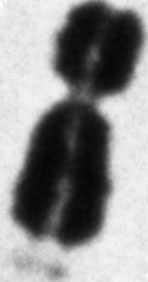Archived Content
The National Institute of Mental Health archives materials that are over 4 years old and no longer being updated. The content on this page is provided for historical reference purposes only and may not reflect current knowledge or information.
Clinical Tests Begin on Medication to Correct Fragile X Defect
• Press Release

NIH-supported scientists at Seaside Therapeutics in Cambridge, Mass., are beginning a clinical trial of a potential medication designed to correct a central neurochemical defect underlying Fragile X syndrome, the most common inherited cause of intellectual disability. There has to date been no medication that could alter the disorder's neurologic abnormalities. The study will evaluate safety, tolerability, and optimal dosage in healthy volunteers.
The work is the outcome of basic research that traced how an error in the fragile X mental retardation gene (FMR1) leads to changes in brain connections, called synapses. The changes in turn appear to be the mechanism for learning deficits in Fragile X syndrome. The new trial tests Seaside Therapeutics' novel compound, STX107, that selectively and potently targets the synaptic defect.
Thomas R. Insel, M.D., director of the National Institute of Mental Health, said, "This project is the culmination of years of fundamental research, first identifying the genetic mutation and later deciphering the biochemical consequences of this mutation. Now, with the initiation of this first clinical study, we move one step closer to understanding how this novel candidate may play a critical role in improving the lives of individuals with Fragile X Syndrome."
Randall Carpenter, M.D., president and chief executive officer of Seaside Therapeutics, and Mark Bear, Ph.D., Seaside's scientific founder, are leading the research. Dr. Bear is a Howard Hughes Medical Institute investigator and a professor of neuroscience at the Massachusetts Institute of Technology, Cambridge, Mass.
The National Institute of Mental Health, the Eunice Kennedy Shriver National Institute of Child Health and Human Development (NICHD), and the National Institute of Neurological Disorders and Stroke (NINDS) have provided grant support. Private foundations providing funding include the advocacy groups Autism Speaks and FRAXA Research Foundation.
Fragile X syndrome is the most common inherited cause of intellectual disability, affecting an estimated 1 in 4,000 males and 1 in 6,000 females. The syndrome causes a range of developmental problems, including learning disabilities and cognitive impairment. People with Fragile X syndrome may have anxiety and attention deficit hyperactivity disorder. About one-third of males with Fragile X syndrome also have autism or autistic-like behavior that affects communication and social interaction. Usually, males, who have only a single X chromosome, are more severely affected than females.
People with Fragile X have DNA mutations in the FMR1 gene that, in effect, turn off the gene. Research in recent years by Dr. Bear and colleagues has identified the molecular consequences of this silencing of FMR1. Normally, the protein product of the FMR1 gene acts to dampen the synthesis of proteins at synapses that are stimulated via a specific class of receptors on brain cells––metabotropic glutamate receptors (mGluRs). Without the brake provided by FMR protein, synaptic protein synthesis is excessive and connections do not develop normally.
This basic research provided the basis on which to develop medications that could correct the defect.
The current study will focus on a compound, designated STX107, that selectively inhibits one type of mGluR receptor, mGluR5. Evidence in mice with Fragile X-like symptoms suggests that reducing levels of mGluR5 can restore normal synaptic protein synthesis and improve function.
The initial phase 1 study of STX107 will involve healthy volunteers. If results suggest that the medication is safe and tolerable, the study will progress to a phase 2 test of dosage and efficacy in adults with Fragile X syndrome. If STX107 shows promise in adults, the compound will be assessed for pediatric safety (with funding from the Best Pharmaceuticals for Children Act through NICHD) prior to initiating clinical trials in children.
For more information on clinical trials related to Fragile X syndrome, visit the Clinical Trials website.
About the National Institute of Mental Health (NIMH): The mission of the NIMH is to transform the understanding and treatment of mental illnesses through basic and clinical research, paving the way for prevention, recovery and cure. For more information, visit the NIMH website.
About the Eunice Kennedy Shriver National Institute of Child Health and Human Development (NICHD): The NICHD sponsors research on development, before and after birth; maternal, child, and family health; reproductive biology and population issues; and medical rehabilitation. For more information, visit the NICHD website.
The National Institute of Neurological Disorders and Stroke (NINDS ) is the nation’s leading funder of research on the brain and nervous system. The mission of NINDS is to seek fundamental knowledge about the brain and nervous system and to use that knowledge to reduce the burden of neurological disease.
About the National Institutes of Health (NIH): NIH, the nation's medical research agency, includes 27 Institutes and Centers and is a component of the U.S. Department of Health and Human Services. NIH is the primary federal agency conducting and supporting basic, clinical, and translational medical research, and is investigating the causes, treatments, and cures for both common and rare diseases. For more information about NIH and its programs, visit the NIH website .
NIH…Turning Discovery Into Health®
